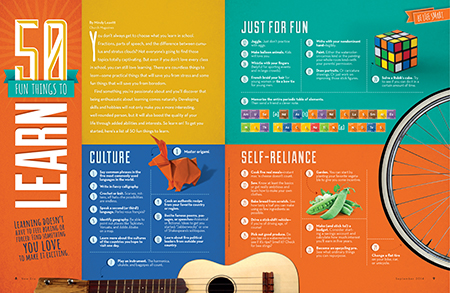50 Fun Things to Learn
Learning doesn’t have to feel boring or forced. Find somethingyou love to make it exciting.
You don’t always get to choose what you learn in school. Fractions, parts of speech, and the difference between cumulus and stratus clouds? Not everyone’s going to find those topics totally captivating. But even if you don’t love every class in school, you can still love learning. There are countless things to learn—some practical things that will save you from stress and some fun things that will save you from boredom.
Find something you’re passionate about and you’ll discover that being enthusiastic about learning comes naturally. Developing skills and hobbies will not only make you a more interesting, well-rounded person, but it will also boost the quality of your life through added abilities and interests. So learn on! To get you started, here’s a list of 50 fun things to learn.
Culture
- 1. Say common phrases in the five most commonly used languages in the world.
- 2. Write in fancy calligraphy.
- 3. Crochet or knit. Scarves, mittens, elf hats—the possibilities are endless.
- 4. Speak a second (or third!) language. Parlez-vous français?
- 5. Identify geography. Be able to point out places like Tajikistan, Vanuatu, and Addis Ababa on a map.
- 6. Learn more about the cultures of the countries you hope to visit one day.
- 7. Play an instrument. The harmonica, ukulele, and bagpipes all count.
- 8. Master origami.

- 9. Cook an authentic recipe from your favorite country or region.
- 10. Recite famous poems, passages, or speeches—historical or fictional. Ideas to get you started: “Jabberwocky” or one of Shakespeare’s soliloquies.
- 11. Learn about five political leaders from outside your country.
Just for Fun
- 12. Juggle. Just don’t practice with eggs.
- 13. Make balloon animals. Kids will love you.
- 14. Whistle with your fingers (helpful for sporting events and in large crowds).
- 15. French braid your hair for young women or tie a bow tiefor young men.
- 16. Memorize the entire periodic table of elements. Then send a friend a clever note.

- 17. Write with your nondominant hand—legibly.
- 18. Paint. Either the watercolor-on-canvas kind or the painting-your-whole-room kind—with your parents’ permission.
- 19. Draw portraits. Or caricature drawings. Or just work on improving those stick figures.
- 20. Solve a Rubik’s cube. Try to see if you can do it in a certain amount of time.
Self-Reliance
- 21. Cook five real meals—instant mac ’n cheese doesn’t count.
- 22. Sew. Know at least the basics or get really ambitious and learn how to make your own clothes.
- 23. Bake bread from scratch. See how tasty a loaf you can make using as few ingredients as possible.
- 24. Drive a stick-shift vehicle—if you’re of driving age, of course!
- 25. Pick out good produce. Do you tap on a watermelon to see if it’s ripe? Smell it? Check for bee stings?
- 26. Garden. You can start by planting your favorite vegetable to give you some incentive.
- 27. Make (and stick to!) a budget. Consider starting a savings account and calculate how much interest you’ll earn in five years.
- 28. Become an upcycling pro. See what ordinary things you can repurpose.
- 29. Change a flat tire on your bike, car, or unicycle.
Helpful Skills
- 31. Write HTML or other computer code. It’s almost like learning a new language.
- 32. Create a web page. Wouldn’t you like to have your own .com?
- 33. Become skilled at storytelling. Memorize some fairy tales while you’re at it.
- 34. Be comfortable with public speaking—without passing out.

- 35. Write in shorthand, or in other words, taking notes really fast. It’s useful for learning from all of those quick-speaking teachers at school or in Church meetings.
- 36. Do creative writing. Or tell your story, but tell it in a fun way.
- 37. Learn to iron like a pro.
Spiritual/Church
- 37. Index at familysearch.org/indexing. You’ve heard about it. You’ve thought about it. Now go do it and see how fun it really can be. Want to learn how to index? Ask your parents if you can throw an indexing party.
- 38. Choose some favorite people from Church history—whether it be the Apostle Paul, a latter-day prophet, Emma Smith, or Parley P. Pratt. Learn facts about them and memorize quotes by them. Identify one of their Christlike attributes and work to develop it in your life.
- 39. Learn about the countries your ancestors came from.
- 40. Play a hymn or conduct music.
- 41. Find family history stories and discover what you have in common with your ancestors.
- 42. Study symbols or objects from the scriptures whose meaning you don’t understand. You can divide it into categories, such as colors (red, white), body parts (shoulders, heart), animals (lamb, wolf), clothing (robe, hem), food (milk, fruit), natural elements (fire, water), places (Zion, Dead Sea), numbers (7, 40), objects (swords, oil), and nature (trees, sand).
- 43. Memorize favorite scriptures, the family proclamation, or “The Living Christ: The Testimony of the Apostles.”
Health & Safety/Outdoors
- 44. Learn CPR and basic first-aid. Being prepared can feel pretty cool.
- 45 Tie different kinds of knots, Navy-style.
- 46. Learn to protect yourself with self-defense.
- 47. Identify constellations and research astronomy: black holes, nebula, supernova—it just sounds cool.
- 48. Learn a new sport. Consider swimming (after all, 71 percent of the earth’s surface is covered by water).
- 49. Navigate somewhere new. Try it with a paper map and a compass before using GPS.
- 50. Country, swing, or ballroom dance—unless you’re more interested in Irish hard shoe.
Find Something You Love
President Henry B. Eyring, First Counselor in the First Presidency, learned a great lesson from his father: “Because of his great love for science, [his father] encouraged each of his sons to major in physics. … Hal [President Eyring] was studying physics … [and] asked his father for help with a complex mathematical problem. … ‘Hal,’ [his father] said, ‘we were working this same kind of problem a week ago. You don’t seem to understand it any better now than you did then. Haven’t you been working on it?’ …
“Hal admitted he had not. ‘You don’t understand,’ his father went on. ‘When you walk down the street, when you’re in the shower, when you don’t have to be thinking about anything else, isn’t this what you think about?’
“‘When I told him no,’ [said President Eyring,] ‘my father paused. … Then he said, “Hal, I think you’d better get out of physics. You ought to find something that you love so much that when you don’t have to think about anything, that’s what you think about.”’”
From Gerald N. Lund, “Elder Henry B. Eyring: Molded by ‘Defining Influences,’” Ensign, Sept. 1995, 10–11.
Learning Your Learning Style
Whether you’re learning something for school or for fun, it’s important to identify what kind of learner you are. Though most people can get something from every approach, not everyone has the same favored learning style, so finding out how you learn best will help you learn better. Learning better will make learning more fun, too. Here’s a rundown of different learning styles:
LEARNING STYLE
|
YOU LEARN BEST BY
|
LEARNING TIPS
|
|---|---|---|
Visual
|
Seeing
|
At school, sit where you can see the board best. Write down key words, ideas, or instructions. Take notes. Color code things. Draw pictures to help explain new concepts. Look at graphics. Try to visualize things you hear. Use flashcards.
|
Auditory
|
Listening
|
At school, sit where you can hear the teacher best. Make up rhymes or chants to help you memorize things. Have uplifting instrumental music playing while you study. Read assignments, directions, and your notes aloud. At home, don’t be afraid to talk out loud to yourself or others when trying to figure something out.
|
Tactile/ Kinesthetic
|
Being hands-on
|
Participate in activities that involve touching, building, moving, etc. Perform a skit to show the action of what you’re trying to learn. Take notes. Use a highlighter pen to mark important passages. Stay active when you need to concentrate—squeeze a stress ball or walk around as you’re reading a book.
|




0 Comments